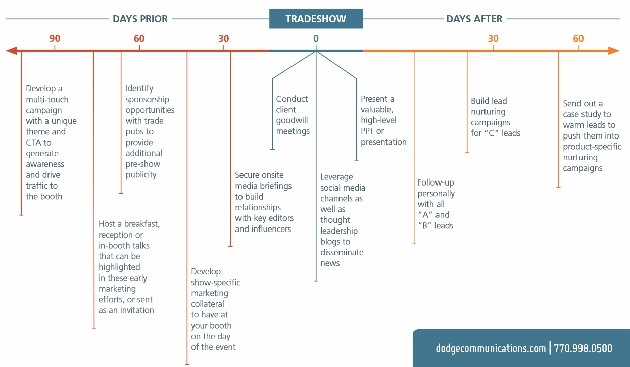Companies benefit in many ways from exhibiting at tradeshow, including by securing face time with busy executives—a coveted advantage in today's marketplace. Asked to rank the most effective ways to brand and generate demand, nearly 50% of respondents to a 2014 Chief Marketing Officer Council study cited events and tradeshows.
Other channels have their advantages, but they are no substitute for direct contact. Being physically present gives B2B innovators an opportunity to build and solidify relationships with clients and prospects. It also offers them the chance to compare how well they stack up against other players on the showroom floor.
But, let's face it: Factoring in booth and travel costs, per diems, and limited availability to clients... events are expensive. It's critical, therefore, to make sure the time and resources you're investing generate leads and a real return on investment.
The solution? Enhance your next live, face-to-face event with the behind-the-scenes genius and expediency of marketing automation, including email, to maximize lead generation and ROI.
With its ability to link offline events to online marketing efforts, such as lead nurturing, marketing automation can help streamline marketing and sales tasks before, during, and after a tradeshow, taking care of a lot of the heavy lifting for users.
Hidden Powers for Super End-to-End Performance
The days of tradeshows' being logistical nightmares are a thing of the past. With marketing automation, you can transform mild-mannered traditional and online events into knockout multichannel programs that enhance brand awareness, nurture leads, and drive sales.
Preparation
Tradeshow success depends on preparation. If you want people to visit your booth, you need to make sure that they know you're going to be there. The following are among the pre-show outreach tactics you should be using in the months and weeks leading up to the event:
- Targeted email campaigns. Develop an email campaign that will drive tradeshow attendees to schedule an in-person appointment or demo at the show. Use a dedicated landing page with show-specific information to schedule appointments via a form. The intent is to drive interest in your presence and get attendees to pre-register for whatever event, demo, or promotion will be there to learn more about your services. Notify prospects of any promotion or specials that will be offered at the show (during the conference, some companies offer discounts or wave set-up fees).
- Audience outreach. Develop a list of attendees for your tradeshow email campaign and segment your prospects based on their interests or location, making sure none of your current customers are on the list. If there's a possibility some people might get an email that doesn't pertain to them, you may choose to place those customers on a suppression list.
- Right messaging. Segment your lists into prospects and current customers, tailoring the email content to each audience. Doing so ensures customers don't receive prospecting emails or special offers that may not apply to them. Target customers separately to generate upsell opportunities at the show and consider using marketing automation to personalize emails from their individual sales rep.
- Tie-ins. Aside from emails, tie in other campaign elements. Use direct mail, social media, and the company website and blog through an integrated approach that generates awareness and drives traffic to the dedicated landing page.
- Deliverables. Once you've delivered highly tailored messaging to attract visitors, don't forget the goods. Ensure you have relevant pieces of collateral to show those who are attracted to your booth through the above tactics.
Execution
At the main event, the point is to make a personal connection, solidifying relationships, getting to know prospects, and representing the company. The last thing you need is to get mired in paperwork. Marketing automation can do the heavy lifting of gathering information and uploading it into your database.
During the show, tap into the power of marketing automation to cover these bases:
- Data capture. Ensure your sales team has adequate technology to digitally capture visitors' information for post-show follow-up efforts. Some shows have scanners, or you can use landing pages in kiosk mode on a tablet. By creating dedicated landing pages and forms that can be easily accessed from a laptop or tablet, you don't need to worry about manual data entry, lost forms, or stacks of business cards. The information you collect can be used later for segmentation and targeted follow-up.
- Social presence. Enhance your event and connect with prospects, customers and attendees by developing a strong presence on social media. Consider sending LinkedIn connections invitations to meet at the event or participate in groups. You can also keep track of trends and engage in conversations through channels like Twitter. Tweets can be scheduled and sent through a marketing automation tool before the conference even starts
Follow-up
After the event, the real work begins. In addition to following up with prospects, such as sending an email thanking them for their visit, or offering them a special gift, put your marketing automation to work to nurture leads via relevant content and to measure results. Post-show best-practices include the following:
- Segmenting leads. Looking at the leads added to your marketing automation system, segment the list into two categories: who's hot and who's not. Hot leads should be assigned to the appropriate sales rep in your CRM for individual follow up. Just don't forget to remove assigned leads from the post-show follow-up list to avoid interfering with any open sales cycles. The rest of the leads should be put into a thought leadership/educational nurturing campaign that focuses on providing relevant post-show content to keep your company top-of-mind.
- Creating drip campaigns. For post-show leads that may not be sales-ready, set up drip campaigns that feed informative content to prospects over time. Best practices call for sending an initial follow-up email within two weeks of the show to remind prospects of your company. These emails should focus on providing high quality content that the audience can engage with to learn more about your offerings—such as a recap blog, webinar recording with key takeaways, or video of a tradeshow talk housed on your company's website.
Unmasking ROI
Tradeshows are just one of many projects competing for attention in the department budget. Although they provide a unique opportunity, you still need to be able to justify the time and money that go into them. Marketing automation makes it easier to track, measure, and report on your event's performance.
Since each of your leads from the event was tagged when imported into your system, it's easier to recognize the source of revenue, giving valuable insight into how well your tradeshow efforts are paying off. That insight also allows you to plan for future events, justifying the budget, fine-tuning strategies, and setting realistic performance goals.
At its core, face-to-face engagement creates a personal connection and builds trust between a company and its target audience. Exhibiting at tradeshows gives you a the opportunity to positively promote your brand, position yourself as a thought leader, and generate new leads—as well as network and garner a little publicity. Marketing automation provides a platform that helps you manage all the details, promote your presence through all stages of the event, and demonstrate value.





